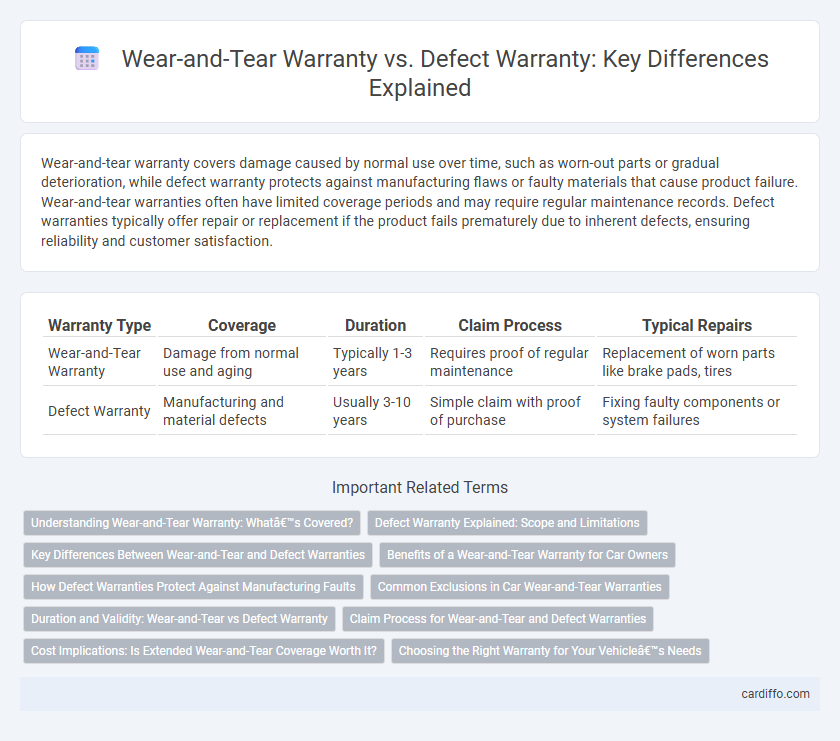Wear-and-tear warranty covers damage caused by normal use over time, such as worn-out parts or gradual deterioration, while defect warranty protects against manufacturing flaws or faulty materials that cause product failure. Wear-and-tear warranties often have limited coverage periods and may require regular maintenance records. Defect warranties typically offer repair or replacement if the product fails prematurely due to inherent defects, ensuring reliability and customer satisfaction.
Table of Comparison
| Warranty Type | Coverage | Duration | Claim Process | Typical Repairs |
|---|---|---|---|---|
| Wear-and-Tear Warranty | Damage from normal use and aging | Typically 1-3 years | Requires proof of regular maintenance | Replacement of worn parts like brake pads, tires |
| Defect Warranty | Manufacturing and material defects | Usually 3-10 years | Simple claim with proof of purchase | Fixing faulty components or system failures |
Understanding Wear-and-Tear Warranty: What’s Covered?
Wear-and-tear warranty primarily covers damage or deterioration resulting from normal usage over time, including issues like worn-out tires, brake pads, and battery depletion. This type of warranty excludes defects caused by manufacturing flaws or faulty materials, which fall under a defect warranty. Understanding the specific components and conditions covered by a wear-and-tear warranty helps consumers manage expectations and avoid unexpected repair costs.
Defect Warranty Explained: Scope and Limitations
Defect warranty covers repairs or replacements for faults arising from manufacturing errors or material flaws within a specified period, excluding damages caused by improper use or wear. This warranty typically ensures that components function as intended under normal operating conditions, defining strict limitations on what qualifies for coverage. Understanding defect warranty scope helps consumers recognize their remedy options when equipment fails due to inherent defects rather than gradual deterioration.
Key Differences Between Wear-and-Tear and Defect Warranties
Wear-and-tear warranties cover damage resulting from normal use over time, while defect warranties protect against manufacturing flaws present at the time of purchase. Wear-and-tear warranties typically exclude parts subject to regular deterioration like tires or batteries, whereas defect warranties address structural or functional malfunctions caused by production errors. Understanding these distinctions helps consumers determine coverage scope and when to file claims based on damage origin.
Benefits of a Wear-and-Tear Warranty for Car Owners
A wear-and-tear warranty offers car owners protection against the gradual deterioration of parts due to normal use, such as brake pads, tires, and suspension components. This type of warranty helps reduce unexpected maintenance expenses by covering common repairs that are not typically included in defect warranties. By ensuring coverage for routine wear items, car owners maintain vehicle reliability and extend the lifespan of essential components without incurring high out-of-pocket costs.
How Defect Warranties Protect Against Manufacturing Faults
Defect warranties specifically cover damages caused by manufacturing faults, ensuring repair or replacement of faulty components without additional cost to the consumer. Unlike wear-and-tear warranties, which exclude damages from regular use, defect warranties protect against inherent material or workmanship failures discovered during the warranty period. This guarantee reduces the risk of financial loss due to product defects, enhancing consumer confidence and product reliability.
Common Exclusions in Car Wear-and-Tear Warranties
Car wear-and-tear warranties commonly exclude coverage for damage resulting from regular use, such as tire wear, brake pad erosion, and fluid depletion. Defect warranties typically cover manufacturing faults but do not apply to maintenance-related issues or parts subject to natural degradation. Understanding these distinctions helps vehicle owners discern which repair costs are their responsibility versus those eligible for warranty claims.
Duration and Validity: Wear-and-Tear vs Defect Warranty
Wear-and-tear warranties typically cover a limited duration, often ranging from six months to two years, focusing on damages caused by normal usage over time, whereas defect warranties generally extend longer, sometimes up to lifetime, covering manufacturing flaws and material defects. Wear-and-tear warranty validity diminishes as the product undergoes expected deterioration, while defect warranties remain valid as long as the flaw impairs proper function without signs of misuse. Understanding the specific coverage periods and conditions for each warranty type is essential for maximizing protection on consumer products.
Claim Process for Wear-and-Tear and Defect Warranties
Claim processes for wear-and-tear warranties typically require evidence of gradual damage due to normal use, often involving inspection reports and maintenance records to validate the claim. Defect warranty claims focus on proving manufacturing or material faults, commonly needing diagnostic tests or expert evaluations submitted to the manufacturer or authorized service centers. Both claim types demand timely submission within warranty periods and adherence to specific documentation guidelines outlined in the warranty agreement.
Cost Implications: Is Extended Wear-and-Tear Coverage Worth It?
Wear-and-tear warranty typically covers gradual degradation due to normal use, often incurring higher premiums to account for predictable replacement costs, while defect warranty addresses unexpected manufacturing faults with generally lower costs. Extended wear-and-tear coverage can significantly increase upfront expenses but may reduce out-of-pocket repair or replacement costs over time, especially for high-use or older products. Evaluating the product's typical lifespan, frequency of repairs, and repair cost trends helps determine if the extended wear-and-tear warranty offers cost-effective protection.
Choosing the Right Warranty for Your Vehicle’s Needs
Selecting the right warranty involves understanding the distinction between wear-and-tear and defect coverage to protect your vehicle effectively. Wear-and-tear warranties address components that naturally degrade over time, such as brake pads and tires, while defect warranties cover manufacturing flaws in parts like the engine or transmission. Evaluating your driving habits and vehicle condition helps determine whether comprehensive protection or targeted defect coverage best suits your maintenance budget.
Wear-and-Tear Warranty vs Defect Warranty Infographic

 cardiffo.com
cardiffo.com